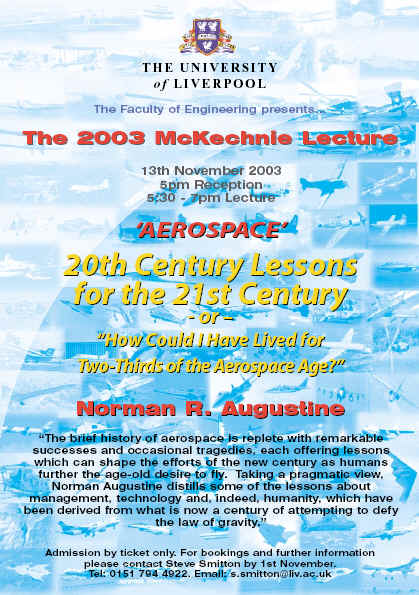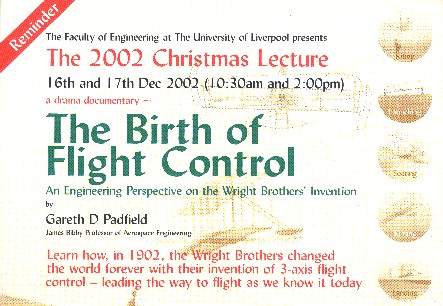 |
Flight Science & Technology Research Group |
||
|
News & Events |
|||
Department Home
Page
Feedback: mdw@liv.ac.uk |
11th March 2005 Flight Science & Technology Red Nose Day ‘05 As part of the national Red Nose Day fund raising event, the Flight Science and Technology Research Group in the Department of Engineering held a “Catch the Pigeon” flying competition. Using the full motion Bibby Flight Simulator, competitors flew around a race track trying to set the fastest time to complete a lap and were penalised for missing any gates. Participants made a donation to enter the competition and to use the X-Plane flight simulator, whilst visitors dropped in to get “refuelled” with a tea, coffee and cake sale. The event was supported by a local flying school, Ravenair www.ravenair.co.uk, who donated a Flight Experience at Liverpool Airport as a prize for the best flyer. Over £200 was raised on the day and Gavin Kennedy from Computing Services was the winner. Miss Helen Baker, a PhD student in the Flight Science and Technology Research Group who organised the event said of the day, “It was a busy day but very rewarding, not only because we contributed to Comic Relief, but also because of the huge smiles on the competitors faces when they came out of the simulator. Our thanks to all who took part.”

Red Nose Day ’05 Flying Team

Gavin Kennedy – Red Nose Day ’05 “Top Gun”
9th March 2005 Flying High The North West Aerospace Alliance held its Sir Frank Whittle Award for final year aerospace student projects on Wednesday 9th March at Manchester Airport. Sponsored by Rolls Royce, the award goes to the student whose industry related final year project is judged the most innovative and demonstrates the strongest potential in the aerospace sector. This year, three of the eight finalists were from the University of Liverpool. Victoria Brookes and Andrew Moon were awarded special commendations and Stephen Kendrick won the Sir Frank Whittle Award and £1000 for best overall project for his work on Helicopter Handling Qualities. Stephen, now studying for a PhD in the Flight Science and Technology Research Group in the Department of Engineering said “Its always nice when your hard work is recognised and I was especially honoured to receive such a prestigious award.” In addition to the individual awards for best student project, The University of Liverpool was awarded the University of the Year prize, which was accepted by the Flight Simulation Laboratory Manager Dr Mark D White on behalf the University.

Sir Frank Whittle Award Winners and Runner-Up (From left to right Sir Stephen Brown (Chief Exec, UK Trade & Investment) Emma Reynolds (2nd place, UCLAN) Bob Morley (Rolls-Royce) Stephen Kendrick (winner, UoL) Dr Mark D White (UoL), Dennis G Mendoros OBE, NWAA Chairman))

Sir Frank Whittle Award, UoL Winners Dr Mark White and Stephen Kendrick with Robert Morely (Rolls Royce)
1st February 2005 Dr. Neil Cameron has begun a new project called “Perfecting Handling Qualities for Future Tilt Rotor/Wing Aircraft”. The project is funded via the EPSRC and also includes one doctoral training award. January 2005
QinetiQ, one of the UK's leading defence and
security technology companies has granted an ICASE Award
(Industrial Co-operative Award in Science and Engineering) to
the FS&T Research Project "Flight Envelope Expansion through
Modelling and Simulation", the PhD project of
Helen Baker and
supervised by Professor Gareth Padfield.
Conference Report: AIAA Aerospace Sciences Meeting and Exhibit, Reno, Nevada, 8-13th Jan, 2005
Dr Ben Lawrence
Recently I attended the AIAA’s annual Aerospace Sciences conference which has been hosted for quite some years in Reno, Nevada. I was requested to make a brief, entertaining and informative report of my trip, so this is my attempt, I cannot promise you any of the above.
The day of departure started promisingly, I arrived at Manchester airport with no delays and checked in my luggage with no problems. I was continuing as normal as I had already taken the precaution to telephone the airport earlier to check on the status of flights. I had done this because the Friday night had been one of the windiest for many years. Naively, I believed the woman that answered, and with a tone of voice that indicated I was a complete idiot, she informed me that all flights were going ahead as normal.
So, naturally, waiting in the departure lounge I was soon informed over the PA system that my flight was to be delayed by 2-3 hrs due to the adverse weather conditions over the UK! Fortunately the initial prediction for the delay was pessimistic and I managed to get airborne about 1 ½ hrs late. The flight was pretty hairy, both at take-off and landing with some very strong gusts; I could literally feel armrests being crushed under the grip of nervous passengers! In Heathrow I arrived with 10 minutes to spare at the boarding gate for my transatlantic flight. It was my first time in a 747 – albeit being right at the back in ‘pleb’ class. The 10hr flight was pretty uneventful except for some interesting scenery over Greenland and the Rockies.
I arrived in Phoenix, AZ ok, spent over 1hr in immigration and was the very last person through (don’t ever pick the queue I’m in!) and just to top it off I discovered that BA couldn’t be bothered to put my luggage on the plane so I had to wear the same clothes for 2 ½ days (Insert your jokes here). By this point I thought I deserved a beer or ten so I headed for a bar whilst I waited for my flight onward to Reno. Firstly, I checked the screens - everything was on time, so off I went. After spending 1 ½ hrs and two beers trying to understand American Football I came out to check the screen and to head for my gate, only to discover my flight had been cancelled! Luckily it was relatively painless; we got a number to call to get a hotel and the got first flight out the next morning.
Reno looked quite nice under the worst snow-fall they’d had since WW2, anyway the skiers looked happy even thought the avalanche threat was high. Got to the hotel after jumping a cab with some other conference delegates (you can spot an engineer from miles away) and was greeted with enough flashing lights that the hotel must have had a nuclear power station tucked away somewhere. Reno is in Nevada which has legalised gambling and the hotel featured a pretty big casino. Incidentally, my gambling exploits in the week reached the grand total of $1.25, winnings - zilch.
Anyway, I must remember that purpose of this trip was the conference after all. I was due to present my paper ‘The Flight Handling Qualities of the 1905 Flyer III’ at 8:00 am on the Monday morning. I received my wayward bag at 6:30 am on the Monday – just in time. The presentation seemed to go well, a good audience who seemed to nod at all the right times and of a reasonable size. I also met the esteemed Dr Barnes. W. McCormick (of the textbook) who had come to see my talk, he seemed to be one of those people who everyone has a great respect for. The rest of the conference was good overall, saw plenty of interesting presentations although I felt there was a slight overbalancing towards CFD methods and applications, it seemed to sneak into presentations everywhere. Other interesting presentations including a development of vortex-ring model in FLIGHTLAB from a guy from Georgia tech, UAV’s with inflatable wings, A method for developing generic control laws for any flight vehicle (i.e. make any aircraft fly the same) and a good one about aircraft trailing vortices (I’m getting the CD so see me if you want any papers). There were keynote speeches at the end of each days and receptions held in the exhibitions where every got have a drink and a bite whilst chatting about engineering. I remember meeting one guy from NASA’s hyper-X program, he was a nice guy and very enthusiastic, but I don’t think they let him out enough.
I never got to downtown Reno, although from all accounts I didn’t miss much and I left for home on the Thursday (13th). The return journey was much less eventful although my bag went missing again as I apparently didn’t have the required ‘sticker’ for my luggage –it arrived at home about 5 hours after I did.
Overall it was a good trip and I enjoyed the experience, for those of you that haven’t done conferences yet it’s a good experience in different ways, I recommend it. Finally, Thanks go to the Royal Aero Society and the Royal Academy of Engineers for funding my research and the trip.
Ben Lawrence University of Liverpool 28/01/05
16th August 2004 Mr Steven Kendrick, a Liverpool aerospace graduate, has joined FS&T to do a PhD looking at helicopter operations with underslung loads
February 2004 Ben Lawrence has started work on a new Framework 6 Programme called OPTIMAL (Optimised Procedures And Techniques For Improvement Of Approach And Landing). The project is lead by Airbus and runs for 3 years at Liverpool who will be investigating rotorocraft operations.
Four new members have joined the FST group: Mr Rob Armstrong working on Simulation Fidelity Miss Helen Baker looking at flight envelope expansion Dr Ridwan Kureemun who has joined Dan Walker and Gareth Padfield on the active control technology for helicopters Mr Heath Lockett will be involved in the Prospective Skyguides project but looking at Nap of the Earth helicopter operations
Photos available on the staff page McKechnie Lecture 2003
Professor Gareth Padfield is giving the Christmas Lecture this year, "The Birth of Flight Control - An Engineering Perspective on the Wright Brothers' Invention". The lecture is aimed mainly at school children in years 10, 11 and 12, but there may be some availability for the general public. Two morning and afternoon sessions are available (Monday 16th and Tuesday 17th December). For bookings and further details, please contact Anne Roberts via email (annerobe@liv.ac.uk) or call 0151-794-4923.
|
||
| All pages © The University of Liverpool, 2003 | Last reviewed 01/11/2005 . Disclaimer. | |||

 Gary
Clark has started a PhD working with ONERA. The main focus of his
research is the
"
Gary
Clark has started a PhD working with ONERA. The main focus of his
research is the
"